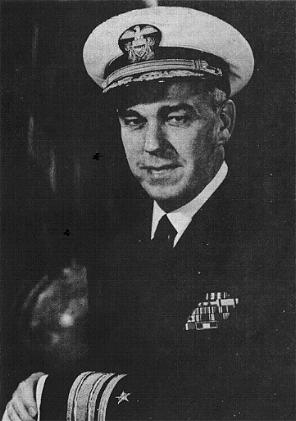

REAR ADMIRAL FREDERICK J. BECTON
UNITED STATES NAVY

Rear Admiral F. J. Becton
|
.jpg)
Rear Admiral's Flag
|
Frederick Julian Becton was born in Des Arc, Arkansas and was educated in Hot Springs, Arkansas. He is the son of the late Mr. and Mrs. John E. Becton
After graduation from the U.S. Naval Academy, Rear Admiral Becton served successively in the battle-ships TEXAS and ARKANSAS, the destroyers WILLIAM B. PRESTON and BRECKINRIDGE, the Yangtze River Gunboat GUAM, and the destroyers POPE, GLEAVES and AARON WARD. He was Executive Officer and later Commanding Officer of the AARON WARD and Operations Officer on the Staff of COMDESRON 21.
In late 1943, Rear Admiral Becton became Commanding Officer of the LAFFEY (DD-724). The ship participated in the Normandy Invasion and the amphibious assault on Okinawa. As a radar picket at Okinawa, the LAFFEY withstood an attack by 22 Kamikaze planes on 16 April 1945. The ship shot down nine of the planes. Five Kamikaze planes crashed into the ship. The LAFFEY was awarded the Presidential Unit Citation for this action.
Since World War II, Rear Admiral Becton has served as Executive Officer of the cruiser MANCHESTER, Commander of a Destroyer Division, Commanding Officer of the attack transport GLYNN and Commanding Officer of the battleship IOWA.
His decorations include the Navy Cross, the Silver Star Medal with three additional gold stars in lieu of second, third and fourth awards, a Commendation Ribbon with a star in lieu of second award, the Croix de Guerre with Gold Star, and the Pacific Ribbon with seven stars.
Admiral Becton is married to the former Elizabeth Hilary Reuss of Wynnewood, Pennsylvania. They have two daughters, Hilary, nine, and Julie, three.
Frederick Julian Becton, a retired Navy Rear Admiral who was awarded the Navy Cross for refusing to give up his ship after one of the most punishing attacks of WWII, died Sunday, December 24, 1995 in Wynnewood, Pennsylvania at age 87.
A native of Arkansas and a 1931 graduate of the U.S. Naval Academy, Admiral Becton was a lieutenant when the war broke out. He was to see action in the Atlantic and Pacific Theaters and would win many decorations and medals for his exploits. The most dramatic came in April 1945, when the destroyer USS Laffey, commanded by Admiral Becton, was off Okinawa on radar picket duty. The Laffey was a relatively new ship but had already been bloodied - in June 1944, when it supported the D-Day invasion of Normandy and participated in the bombardment of Cherbourg, France. Among its scars from that engagement was an unexploded 8-inch shell lodged in the superstructure.
By this late stage of the war, the Japanese had begun to expand the use of kamikaze attacks, the suicidal crashing of armed planes into Allied ships. For the Laffey, the attack began shortly after sunrise April 16 with a formation of four planes. The kamikazes split up to make it more difficult for the crew to keep guns trained on them, and the assault was on. It was to last 79 minutes, and eventually, 22 planes drew a bead on the Laffey. Admiral Becton, wearing a steel helmet and life vest, stood in the open to better see the action. Planes seemed to come from every direction and altitude, he said in an Inquirer interview shortly before the 50th anniversary of the battle this year. Though the Laffey's gunners and those from nearby craft were aided by US warplanes, some of the kamikaze inevitably found their mark.
"Each time one crashed, there was always a flood of gasoline from the plane - and one hell of a fire," Admiral Becton told The Inquirer. The guns took out at least eight of the planes, but five hit the destroyer, jamming its rudder and spreading fire everywhere. "Near the end of the action, one of my officers, Frank Mason, came to me and said, 'Captain, we're in pretty bad shape aft. Do you think you'll have to abandon ship?' "It never entered my mind to abandon ship. The ship might sink under us. We might not be able to sail her. But I wasn't going to abandon her. "So I said, 'No, Frank, I'll never abandon ship as long as a gun will fire.' "
Thirty-one crew members died, and the Laffey had to be towed to Seattle, where a newspaper reported that it was "riddled like a sieve above the water line." The citation for the Navy Cross praised Admiral Becton's "extraordinary heroism" in keeping his ship afloat and in action.
He was promoted to captain in 1951 and to rear admiral in 1959, and was assigned to the Bureau of Naval Personnel and other posts. When he retired in 1966, he and his wife, the former Elizabeth Hilary Reuss, moved to her hometown of Wynnewood. He wrote a book on his experience - The Ship That Would Not Die - and kept in touch with many former crew members.
He is also survived by two daughters, Hilary Becton Wagner and Julie Bradford Becton. A viewing will be held at 10 am January 3, 1996 at Ardmore Presbyterian Church, Montgomery Avenue and Mill Creek Road; a service will follow at 11 am. Burial will be 11 am January 4, 1996 at Arlington National Cemetery.



.jpg)